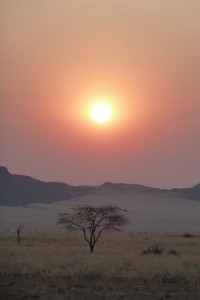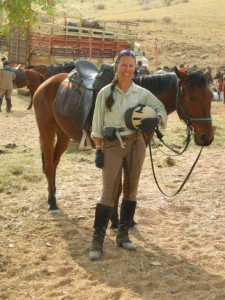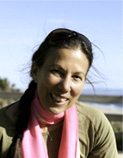Some say, once you’ve been to Africa either you leave it forever, or it’s in your blood like a malaria parasite and you are forever drawn to return. I’m in the latter category. Nothing could top my horseback safaris in Kenya and Botswana for sheer breathtaking animal and bird life. They were total Out Of Africa experiences, though unfortunately minus Robert Redford. Yet I longed to return to Africa for another riding experience. The Namib Desert ride seemed tailor made for me. Usually horseback safaris try to attract a broad variety of riders. Not so this one. “Toughest ride in the world,” the website trumpeted, followed by “not for the faint hearted,” “an extreme riding challenge,”and “experienced, fit riders only.”
The Namib Desert is the oldest in the world, a place of so little rainfall it’s considered for all intents and purposes completely barren. Having been through Mongolia I figured I knew barren. I had another thing coming. Though the famous red dunes of Sossusvlei are found in the southern Namib, the area we’d be riding through was either rocky or made of coarse, hard-packed sand. Riverbeds hadn’t thrilled to the sound of gushing water for years. Plants and animals that do survive there get moisture from the morning fogs that roll in from the Atlantic ocean. If you’ve ever tried slaking a raging thirst by gulping fog, you know it’s no easy task. Unlike my other two Africa rides, this would be an endurance ride covering 280 miles of harsh ground in an unforgiving climate, taking care of our own horses.
What would possess me to freely sign up for what sounded like a horrible ordeal, let alone pay good money for it? All I can say is that I longed for the intensity of experience from 9 days straight of riding, of having practically no contact with civilization other than our own group, sleeping under the stars, depending on my horse to get me through. I wanted to sit by a small, crackling fire, feeling pleasantly exhausted at day’s end and to eat food cooked over coals the way people had since time immemorial. With, from time to time, a glass of robust red wine.
And that’s not all I wanted. I wanted to water, saddle, feed and clean my horse, as if my life and his depended on it. I wanted to be that pioneer woman I read about as a child, who braved all sorts of hardships with fortitude, a smile, and a timely chocolate cake. Of course, I knew I was hardly in danger of getting lost nor of having to fend for myself. This was a supported trip, with someone to follow who’d been that way before, and a camp staff who would have water and food for us, and most importantly for the horses, each night. But as one rider said, “There is something so compelling about riding a sleek horse across the wide-open expanses of a desert landscape.”
Perhaps more than any other trip I’ve taken, this one made a profound impression on me. Quite honestly it’s not for everyone. One must be willing to spend long hours in the saddle, groom and tack one’s own horse, wait in line for a quick shower in limited water, and sleep in a bedroll. The rewards? A sense of accomplishment like no other, a chance to see landscape like nowhere else on earth, a sense of what really fit, athletic horses can do, a renewed respect for any life form in the harsh desert environment, a vivid memory of a cool wind blowing across my face as I lay in my bedroll, looking at Orion in the great black canopy above me, thinking how that same constellation was the touchstone of my summer skies at home, and how infinitely far away home was at that moment. If travel truly is meant to take you into another world, to lift you out of your habits and comforts and deposit you firmly and fully into another life, this was it.
I fall into a routine fairly quickly. While everyone else has a glass of wine or a gin and tonic or three as soon as we arrive, I focus on the one thing that will cool me off: a shower. Or more accurately, a delicate dribble of water falling on my head. To get to the shower, I must first take care of my horse. His comfort is paramount, because if he doesn’t make it, I don’t. That’s not really true. They wouldn’t leave a paying customer behind in the desert. But I’d have to ride in the truck the rest of the way, a fate that’d be ignominious at best, a terrible waste of money at worst. So I grab flakes of hay, hoist a heavy tub of high-calorie feed, lead him to and from the water trough, grab brushes and curry combs and scratch off the sweat and dust gobs as best I can.
Only when he looks reasonably clean, when his armpits, girth and chest are free of irritants that could cause saddle sores, when I’ve squeezed my thumb and forefinger along his spine to ensure that I’ve ridden him lightly enough that his back isn’t sore, do I turn to my own comfort. That means setting my cot somewhere far enough from the fire that I can sleep while others talk, but close enough to the fire that I feel safe. Finally I grab my little towel and a change of clothes and head to the shower stall. When I get there the water will not be hot. That’s fine with me since I’m usually early enough that the sun is still up and the temperature is subsiding from pizza oven to pleasant sauna. Being the first one to shower means I actually use less water than anyone else. This is because I’m hyper-aware that water is limited and if I squander it someone else will suffer. I wash my hair only every few days. It’s in a long braid, now fairly matted with desert dust. But who cares. My horse is marvelous, the food is great, there’s a crackling fire waiting on which are roasting tiny squashes and lovely potatoes, and I hear we’ll be eating oryx stew tonight. Time for a gin and tonic.
-Dina
If you’d like to know which organization I used for this ride, or more details about it, or have questions about what skill level would enjoy such an experience, post to me below.












